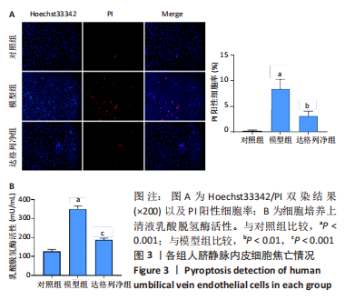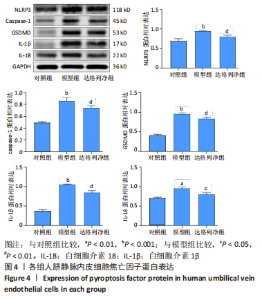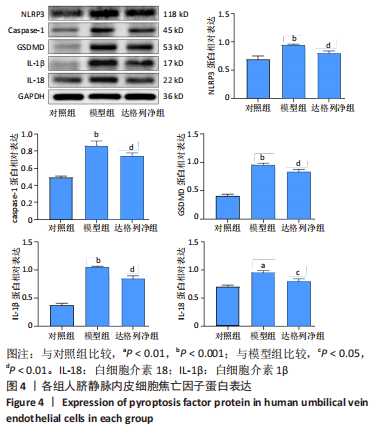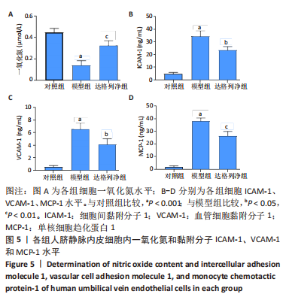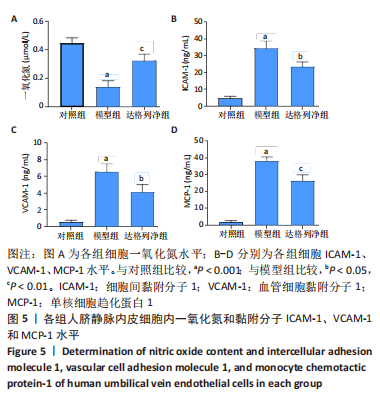Chinese Journal of Tissue Engineering Research ›› 2024, Vol. 28 ›› Issue (1): 80-85.doi: 10.12307/2023.773
Previous Articles Next Articles
Dapagliflozin attenuates endothelial cell pyroptosis and dysfunction induced by oxidized low-density lipoprotein
Zhao Quanwei, Li Hui, Liu Danan, Gong Caiwei, Chen Long
- Department of Cardiology, Affiliated Hospital of Guizhou Medical University, Institute of Medical Sciences, Guizhou Medical University, Guiyang 550004, Guizhou Province, China
-
Received:2022-11-03Accepted:2022-12-27Online:2024-01-08Published:2023-06-28 -
Contact:Liu Danan, MD, Professor, Chief physician, Master’s/Doctoral supervisor, Department of Cardiology, Affiliated Hospital of Guizhou Medical University, Institute of Medical Sciences, Guizhou Medical University, Guiyang 550004, Guizhou Province, China -
About author:Zhao Quanwei, Master candidate, Department of Cardiology, Affiliated Hospital of Guizhou Medical University, Institute of Medical Sciences, Guizhou Medical University, Guiyang 550004, Guizhou Province, China -
Supported by:the National Natural Science Foundation of China, No. 81660083 (to LDN); Guizhou Provincial Science and Technology Innovation Talent Team Project, No. (2020)5014 (to LDN); Guizhou Provincial Hundred-Level Innovative Talent Cultivation Plan, No. (2015)4026 (to LDN)
CLC Number:
Cite this article
Zhao Quanwei, Li Hui, Liu Danan, Gong Caiwei, Chen Long. Dapagliflozin attenuates endothelial cell pyroptosis and dysfunction induced by oxidized low-density lipoprotein[J]. Chinese Journal of Tissue Engineering Research, 2024, 28(1): 80-85.
share this article
Add to citation manager EndNote|Reference Manager|ProCite|BibTeX|RefWorks
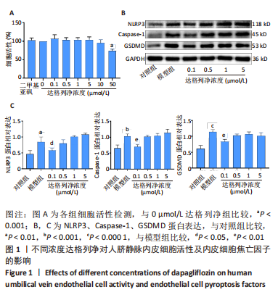
2.1 CCK-8结合Western blot筛选达格列净最适干预浓度 应用不同浓度的达格列净干预正常细胞24 h后,CCK-8结果显示,当达格列净浓度为50 μmol/L时,细胞活性出现显著下降(P < 0.001),表明高浓度达格列净对细胞有一定的毒性作用;此外,因为高浓度二甲基亚砜对细胞有增殖毒性,因此设置最大浓度0.1%二甲基亚砜作为对照,与对照组相比,细胞增殖活性并没有受到影响,排除了二甲基亚砜的影响;与对照组相比,达格列净10 μmol/L组细胞活性出现下降趋势,见图1A,因此,选用达格列净浓度为0.1,0.5,1,5 μmol/L进行Western blot实验。NLRP3作为炎症小体激活的核心,在细胞经典焦亡途径中发挥着关键的作用,而caspase-1作为效应蛋白则执行切割下游因子的功能,GSDMD则作为功能蛋白执行胞膜的打孔作用。该实验检测了NLRP3、caspase-1、GSDMD蛋白的表达来确定达格列净最适干预浓度,结果显示,与对照组相比,模型组NLRP3、caspase-1、GSDMD蛋白表达显著增高(P < 0.01);而与模型组相比,0.1 μmol/L达格列净组NLRP3、caspase-1、GSDMD蛋白的表达下降(P < 0.05), 0.5,1,5 μmol/L达格列净组NLRP3、caspase-1、GSDMD蛋白表达则无统计学差异(P > 0.05),见图1B,C,因此选用达格列净浓度为0.1 μmol/L进行后续实验。"
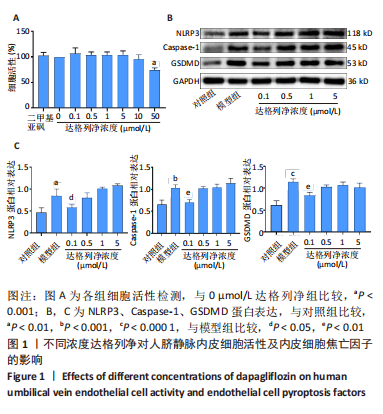
| [1] SITIA S, TOMASONI L, ATZENI F, et al. From endothelial dysfunction to atherosclerosis. Autoimmun Rev. 2010;9(12):830-834. [2] XU S, ILYAS I, LITTLE PJ, et al. Endothelial Dysfunction in Atherosclerotic Cardiovascular Diseases and Beyond: From Mechanism to Pharmacotherapies. Pharmacol Rev. 2021;73(3):924-967. [3] SUN HJ, WU ZY, NIE XW, et al. Role of Endothelial Dysfunction in Cardiovascular Diseases: The Link Between Inflammation and Hydrogen Sulfide. Front Pharmacol. 2020;10:1568. [4] FÖRSTERMANN U, SESSA WC. Nitric oxide synthases: regulation and function. Eur Heart J. 2012;33(7):829-837,837a-837d. [5] LUSIS AJ. Atherosclerosis. Nature. 2000;407(6801):233-241. [6] PAN Y, CAI W, HUANG J, et al. Pyroptosis in development, inflammation and disease. Front Immunol. 2022;13:991044. [7] 胡颖超,杨硕.细胞焦亡的研究进展[J].南京医科大学学报(自然科学版), 2021,41(8):1245-1251. [8] 董娜,邵峰.细胞焦亡的机制和功能[J].中国科学:生命科学,2019,49(12): 1606-1634. [9] 曹朝晖,吴颛,胡小波.细胞焦亡参与动脉粥样硬化形成的分子机制新进展[J].中国动脉硬化杂志,2021,29(7):560-565. [10] ZENG X, LIU D, HUO X, et al. Pyroptosis in NLRP3 inflammasome-related atherosclerosis. Cell Stress. 2022;6(10):79-88. [11] SHI J, GAO W, SHAO F. Pyroptosis: Gasdermin-Mediated Programmed Necrotic Cell Death. Trends Biochem Sci. 2017;42(4):245-254. [12] YANG Z, SHI J, CHEN L, et al. Role of Pyroptosis and Ferroptosis in the Progression of Atherosclerotic Plaques. Front Cell Dev Biol. 2022;10:811196. [13] ZHENG D, LIU J, PIAO H, et al. ROS-triggered endothelial cell death mechanisms: Focus on pyroptosis, parthanatos, and ferroptosis. Front Immunol. 2022;13: 1039241. [14] ZENG W, WU D, SUN Y, et al. The selective NLRP3 inhibitor MCC950 hinders atherosclerosis development by attenuating inflammation and pyroptosis in macrophages. Sci Rep. 2021;11(1):19305. [15] COWIE MR, FISHER M. SGLT2 inhibitors: mechanisms of cardiovascular benefit beyond glycaemic control. Nat Rev Cardiol. 2020;17(12):761-772. [16] RAHADIAN A, FUKUDA D, SALIM HM, et al. Canagliflozin Prevents Diabetes-Induced Vascular Dysfunction in ApoE-Deficient Mice. J Atheroscler Thromb. 2020;27(11):1141-1151. [17] XUE M, LI T, WANG Y, et al. Empagliflozin prevents cardiomyopathy via sGC-cGMP-PKG pathway in type 2 diabetes mice. Clinical Science. 2019;133(15):1705-1720. [18] LIU P, ZHANG Z, WANG J, et al. Empagliflozin protects diabetic pancreatic tissue from damage by inhibiting the activation of the NLRP3/caspase-1/GSDMD pathway in pancreatic β cells: in vitro and in vivo studies. Bioengineered. 2021; 12(2):9356-9366. [19] EL-ROUS MA, SABER S, RAAFAT EM, et al. Dapagliflozin, an SGLT2 inhibitor, ameliorates acetic acid-induced colitis in rats by targeting NFκB/AMPK/NLRP3 axis. Inflammopharmacology. 2021;29(4):1169-1185. [20] 方岩,张唯薇,蒋梦婷,等.达格列净改善糖尿病动脉粥样硬化模型小鼠斑块的作用机制[J].解放军医学院学报,2022,43(2):186-192+198. [21] 毕一鸣,曹丰.内皮细胞功能异常与动脉粥样硬化的研究进展[J].心血管病学进展,2022,43(2):150-153+177. [22] ZHANG P, LUO J, WU T, et al. MiR-32-5p/AIDA Mediates OxLDL-Induced Endothelial Injury and Inflammation. Int Heart J. 2022;63(5):928-938. [23] LUO L, LIANG H, LIU L. Myristicin regulates proliferation and apoptosis in oxidized low-density lipoprotein-stimulated human vascular smooth muscle cells and human umbilical vein endothelial cells by regulating the PI3K/Akt/NF-κB signalling pathway. Pharm Biol. 2022;60(1):56-64. [24] UTHMAN L, HOMAYR A, JUNI RP, et al. Empagliflozin and Dapagliflozin Reduce ROS Generation and Restore NO Bioavailability in Tumor Necrosis Factor α-Stimulated Human Coronary Arterial Endothelial Cells. Cell Physiol Biochem. 2019;53(5):865-886. [25] COLL RC, SCHRODER K, PELEGRÍN P. NLRP3 and pyroptosis blockers for treating inflammatory diseases. Trends Pharmacol Sci. 2022;43(8):653-668. [26] ZANG YH, CHEN D, ZHOU B, et al. FNDC5 inhibits foam cell formation and monocyte adhesion in vascular smooth muscle cells via suppressing NFκB-mediated NLRP3 upregulation. Vascul Pharmacol. 2019;121:106579. [27] LI Y, NIU X, XU H, et al. VX-765 attenuates atherosclerosis in ApoE deficient mice by modulating VSMCs pyroptosis. Exp Cell Res. 2020;389(1):111847. [28] CHEN YC, JANDELEIT-DAHM K, PETER K. Sodium-Glucose Co-Transporter 2 (SGLT2) Inhibitor Dapagliflozin Stabilizes Diabetes-Induced Atherosclerotic Plaque Instability. J Am Heart Assoc. 2022;11(1):e022761. [29] BEHNAMMANESH G, DURANTE GL, KHANNA YP, et al. Canagliflozin inhibits vascular smooth muscle cell proliferation and migration: Role of heme oxygenase-1. Redox Biol. 2020;32:101527. [30] SUKHANOV S, HIGASHI Y, YOSHIDA T, et al. The SGLT2 inhibitor Empagliflozin attenuates interleukin-17A-induced human aortic smooth muscle cell proliferation and migration by targeting TRAF3IP2/ROS/NLRP3/Caspase-1-dependent IL-1β and IL-18 secretion. Cell Signal. 2021;77:109825. [31] LENG W, OUYANG X, LEI X, et al. The SGLT-2 Inhibitor Dapagliflozin Has a Therapeutic Effect on Atherosclerosis in Diabetic ApoE-/- Mice. Mediators Inflamm. 2016;2016:6305735. [32] 林李嘉慧.达格列净通过抑制SGLT-2下调高糖高脂诱导的自噬改善内皮细胞功能紊乱[D].衡阳:南华大学,2021. [33] JAIKUMKAO K, PROMSAN S, THONGNAK L, et al. Dapagliflozin ameliorates pancreatic injury and activates kidney autophagy by modulating the AMPK/mTOR signaling pathway in obese rats. J Cell Physiol. 2021;236(9):6424-6440. [34] TERASAKI M, HIROMURA M, MORI Y, et al. Amelioration of Hyperglycemia with a Sodium-Glucose Cotransporter 2 Inhibitor Prevents Macrophage-Driven Atherosclerosis through Macrophage Foam Cell Formation Suppression in Type 1 and Type 2 Diabetic Mice. PLoS One. 2015;10(11):e0143396. [35] MA L, HAN Z, YIN H, et al. Characterization of Cathepsin B in Mediating Silica Nanoparticle-Induced Macrophage Pyroptosis via an NLRP3-Dependent Manner. J Inflamm Res. 2022;15:4537-4545. |
| [1] | Deng Rui, Huang Keming, Luo Jian, Chen Gong, Feng Jian, Huang Weiyi, Wei Gang. Effect of heme oxygenase-1-mediated atorvastatin on macrophage polarization and cholesterol accumulation [J]. Chinese Journal of Tissue Engineering Research, 2024, 28(1): 62-67. |
| [2] | Fang Xingyan, Tian Zhenli, Zhao Zheyi, Wen Ping, Xie Tingting. Effects of sodium arsenite on human umbilical vein endothelial cell injury and sphingosine kinases 1/sphingosine 1-phosphate signaling axis [J]. Chinese Journal of Tissue Engineering Research, 2023, 27(在线): 1-7. |
| [3] | Han Weiyu, Chen Yuanxing, Huang Youyang, Liu Weiwei, Zhao Yongchao, Zhao Ranzun. Regulation of cardiovascular diseases by histone deacetylation modification [J]. Chinese Journal of Tissue Engineering Research, 2023, 27(35): 5707-5713. |
| [4] | Li Li, Li Xiao, Li Duchenhui, Zhang Jie, Xiao Tianjiao, Kang Jiabing, Tian Ai. Regulation of interleukin-4 on osteoclast differentiation during bone regeneration guided by bone replacement materials [J]. Chinese Journal of Tissue Engineering Research, 2023, 27(34): 5455-5461. |
| [5] | Long Tiaoyu, Bao Lunmin, Wan Xiufang, Li Honghong, Zhang Yundong, Jiang Hongmei. Tolerogenic dendritic cells can inhibit pyroptosis of spleen cells in collagen-induced arthritis rats [J]. Chinese Journal of Tissue Engineering Research, 2023, 27(33): 5363-5369. |
| [6] | Wang Qiuyuan, Liu Youwen, Yue Chen, Hou Hongli, Zhang Xue. Expression and significance of pyroptosis-related factors in patients with rheumatoid arthritis [J]. Chinese Journal of Tissue Engineering Research, 2023, 27(32): 5209-5213. |
| [7] | Wang Shurui, Zhang Yilei, Jiao Weijie, Liu Zhihua, Zhang Kuiming, Cui Yinglin. Effects of Yiqi Tongmai Fang on serum amino acid metabolism of atherosclerotic mice [J]. Chinese Journal of Tissue Engineering Research, 2023, 27(28): 4441-4447. |
| [8] | Lu Xiaojun, Xiong Bohan, Yang Tengyun, Wang Xu, Zhang Yaozhang, Zhong Ruiying, Li Yanlin. Novel programmed cell death of chondrocytes in osteoarthritis [J]. Chinese Journal of Tissue Engineering Research, 2023, 27(28): 4571-4576. |
| [9] | Fang Xingyan, Tian Zhenli, Zhao Zheyi, Wen Ping, Xie Tingting. Effects of sodium arsenite on human umbilical vein endothelial cell injury and sphingosine kinases 1/sphingosine 1-phosphate signaling axis [J]. Chinese Journal of Tissue Engineering Research, 2023, 27(26): 4161-4167. |
| [10] | Long Zhisheng, Fu Liuxiang, Gong Feipeng, Wen Jiabin, Deng Ying, Min Huan, Deng Zhuan, Chen Gang. Expression and significance of pyroptosis associated protein in peripheral tissues with tantalum cage loosening [J]. Chinese Journal of Tissue Engineering Research, 2023, 27(25): 4057-4062. |
| [11] | Wu Yongli, Li Long, Liu Junwei, Liu Di, Wang Duo. Warm-needling moxibusion inhibits NLRP3 inflammasome activation and improves cartilage injury in a rabbit model of knee osteoarthritis [J]. Chinese Journal of Tissue Engineering Research, 2023, 27(20): 3202-3208. |
| [12] | Ou Hangjun, Zhao Guangjian, Pan Yujia, Gong Caiwei, Zhao Quanwei, Liu Danan. Construction of a lentiviral vector overexpressing fibronectin type III domain containing 5 to inhibit apoptosis of endothelial cells [J]. Chinese Journal of Tissue Engineering Research, 2023, 27(2): 216-222. |
| [13] | Zhao Yan, Xia Qiuqiu, Xiang Shaojie, Mao Qiming, Kong Weijun, Du Qian, Liao Wenbo, Xin Zhijun. Exosomal miRNA in the repair mechanism of degenerative diseases of the spine and joints [J]. Chinese Journal of Tissue Engineering Research, 2023, 27(19): 3040-3051. |
| [14] | Wang Jiejie, Yin Junfeiyang, Zhong Jing, Gong Haihuan, Wang Yilin, Zhao Yanyan, Li Yanbing, Huang Wenhua. Properties of surface coatings for 3D printed high density polyethylene scaffolds [J]. Chinese Journal of Tissue Engineering Research, 2023, 27(16): 2501-2509. |
| [15] | Li Fang, Cao Jianmin, Zhai Pengfei, Wang Jianshe, Hong Da. Effects of resveratrol on albumin-induced pyroptosis-related proteins in HK-2 cells [J]. Chinese Journal of Tissue Engineering Research, 2023, 27(14): 2164-2169. |
| Viewed | ||||||
|
Full text |
|
|||||
|
Abstract |
|
|||||


